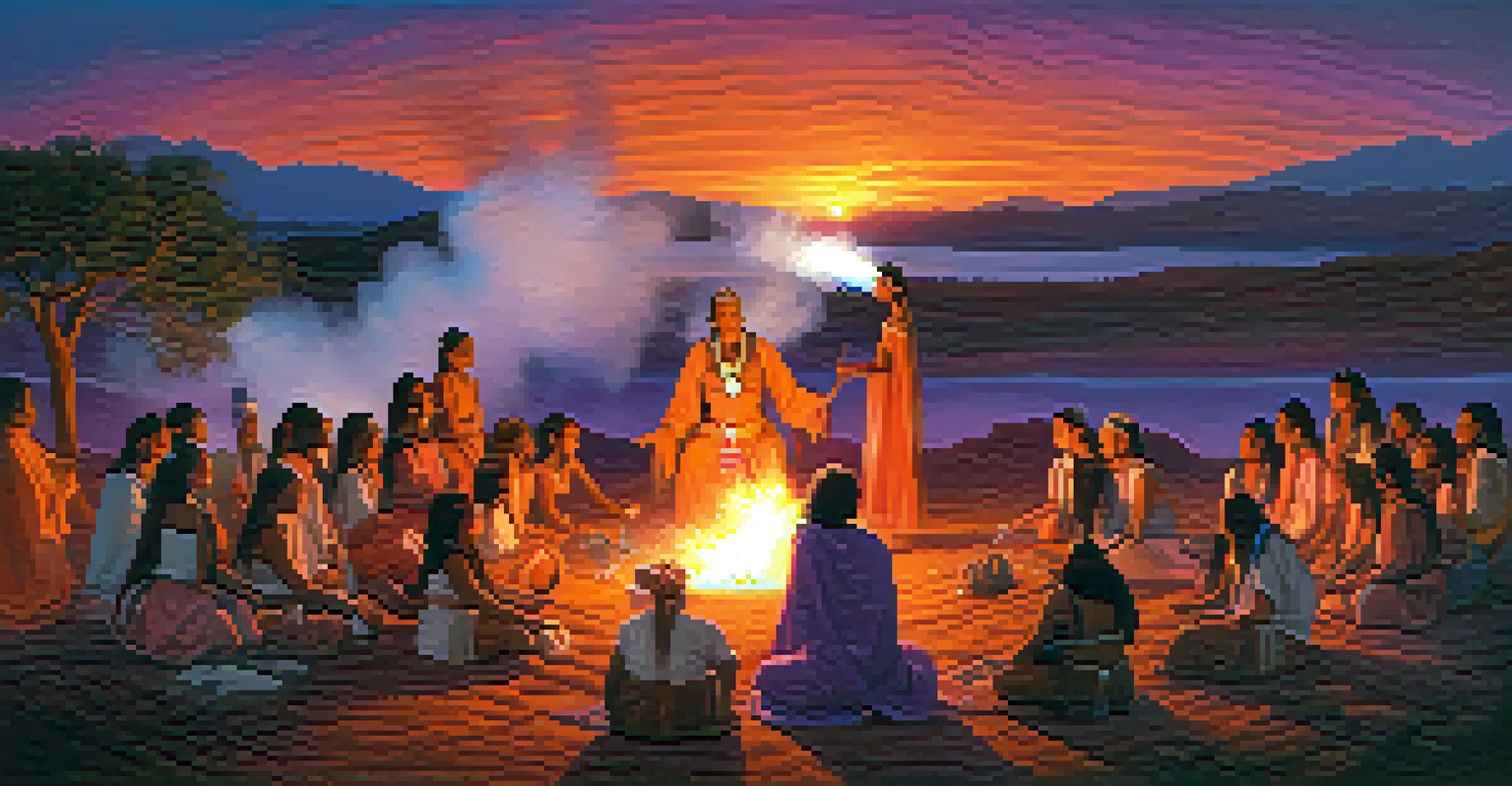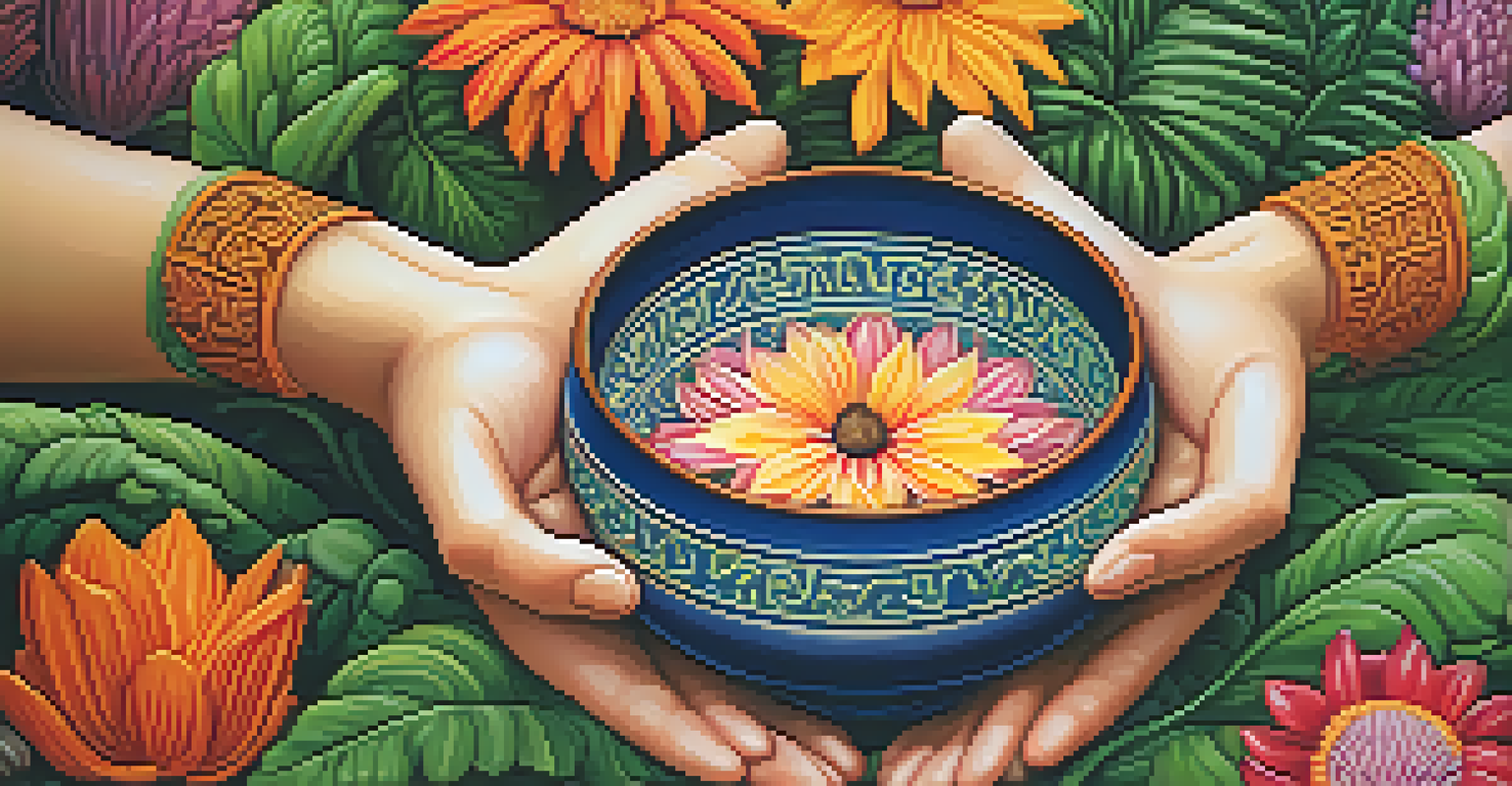Cultural Perspectives on Unity Through Entheogenic Use

Understanding Entheogens and Their Role in Culture
Entheogens are substances that induce altered states of consciousness, often used in spiritual or religious contexts. Cultures around the world have employed these natural compounds for centuries, believing they connect individuals to a higher power or the universe. This connection can foster a sense of unity among participants, transcending individual differences and promoting communal bonds.
Psychedelics can help us reconnect with the world and each other, healing the fractures that have formed in our society.
For instance, Indigenous tribes in the Amazon have long used ayahuasca in ceremonies aimed at healing and spiritual growth. During these gatherings, participants often report profound experiences that deepen their connection to one another and their environment. This shared journey illustrates how entheogens can serve as tools for unity, both within cultures and across diverse communities.
As we explore the various cultural perspectives on entheogenic use, it becomes clear that these practices are about more than just the substances themselves. They are deeply embedded in the social fabric, offering insights into how communities can come together through shared experiences.
Historical Context of Entheogenic Practices
Throughout history, various cultures have turned to entheogens as a means of exploring consciousness and spirituality. From the ancient Greeks using kykeon in the Eleusinian Mysteries to the Native American Church's use of peyote, these practices have been integral to cultural identity. Each of these examples reflects a unique relationship with the substance, shaping communal rituals and beliefs.

In many societies, these practices were often met with resistance from colonial powers or modern legal systems, yet they persisted as vital components of cultural heritage. The resilience of these traditions highlights the importance of entheogens in maintaining cultural unity, even in the face of external pressures. For many, these experiences are not just personal; they are a form of collective identity.
Entheogens Foster Cultural Unity
Entheogens are used across cultures to create shared spiritual experiences that strengthen communal bonds and identity.
Understanding this historical context allows us to appreciate the depth of entheogenic practices. It shows how they have been a source of strength and cohesion for communities, reinforcing the idea that unity can be achieved through shared spiritual experiences.
Modern Revivals and Cultural Renaissance
In recent years, there has been a resurgence of interest in entheogenic practices, often framed within the context of wellness and personal growth. This modern revival is not just a trend; it's a re-examination of ancient wisdom that many believe can address contemporary issues like isolation and disconnection. People are increasingly seeking community through group ceremonies and retreats that utilize these substances.
The experience of unity is not just a state of mind, but a state of being that can transform our relationships and communities.
For example, psychedelic retreats have gained popularity, where individuals come together in a guided environment to explore their consciousness. These gatherings often emphasize unity, healing, and personal transformation, demonstrating that the spirit of entheogenic use is alive and well. Participants frequently report feeling a deep sense of connection with others during these experiences, reinforcing the collective aspect of the journey.
This cultural renaissance signifies more than just a revival of old practices; it's a movement towards inclusivity and shared experiences. By embracing these traditions, modern society is finding new ways to foster unity and connection in a rapidly changing world.
Entheogens as Tools for Community Healing
Entheogenic practices have long been associated with healing, both on individual and community levels. In many cultures, these experiences are seen as pathways to address trauma, grief, and social discord. By creating safe spaces for collective healing, communities can come together to process shared pain and foster resilience.
For instance, in some Indigenous communities, ceremonies involving entheogens serve to heal not just the individual, but the community as a whole. These rituals can facilitate discussions about historical trauma, allowing participants to reconnect and rebuild relationships. The act of sharing these experiences often leads to a renewed sense of purpose and unity.
Modern Revival of Ancient Practices
Recent interest in entheogens reflects a desire for community and healing, as people seek to reconnect through guided ceremonies.
As we explore these practices, it becomes evident that entheogens can bridge gaps within communities. They provide a platform for dialogue, understanding, and healing, reinforcing the idea that unity is not just about shared beliefs, but shared journeys.
Cultural Appropriation vs. Cultural Appreciation
The growing interest in entheogens raises important discussions about cultural appropriation versus appreciation. As people from diverse backgrounds engage with these practices, it’s crucial to navigate the fine line between respecting traditions and appropriating them. Acknowledging the cultural roots of these practices is essential to fostering genuine connections.
For instance, individuals interested in participating in entheogenic ceremonies should seek out authentic experiences led by those within the culture. This approach not only honors the tradition but also supports the communities that have preserved it for generations. By engaging authentically, participants can deepen their understanding and appreciation of the cultural significance.
Ultimately, the conversation around entheogenic use must center on respect and reciprocity. By recognizing the cultural origins and significance of these practices, we can promote unity without diminishing the voices of those who have long relied on these sacred traditions.
Scientific Perspectives on Unity and Connection
Recent scientific studies have begun to explore the effects of entheogens on human connection and unity. Research indicates that these substances can enhance feelings of empathy and compassion, creating a shared sense of purpose among participants. This aligns with anecdotal experiences reported by many who have participated in entheogenic ceremonies.
For instance, studies have shown that psychedelics can alter brain connectivity, leading to increased feelings of connectedness to others and the environment. This scientific backing offers a compelling argument for the role of entheogens in fostering unity, suggesting that these experiences are not just spiritual, but can also be rooted in biology.
Respecting Cultural Roots is Key
Navigating the line between cultural appropriation and appreciation is essential to honor the traditions of entheogenic practices.
By bridging the gap between subjective experience and scientific inquiry, we can gain a deeper understanding of how entheogens facilitate unity. This knowledge reinforces the importance of these practices in modern society, highlighting their potential to bring people together in meaningful ways.
The Future of Entheogenic Practices and Unity
As society continues to evolve, the role of entheogens in fostering unity will likely transform as well. With increasing acceptance and legalization, more people may seek these experiences as a means of connection and healing. This potential shift raises exciting possibilities for how communities can come together in the future.
Moreover, the dialogue surrounding entheogens is expanding beyond individual use to include community-focused initiatives. Workshops, retreats, and educational programs are emerging, emphasizing collective experiences and shared understanding. These developments suggest a growing recognition of the importance of unity in an increasingly fragmented world.

Looking ahead, the future of entheogenic practices holds promise for deepening cultural connections and fostering unity. By continuing to honor the traditions and values associated with these substances, we can pave the way for a more connected and understanding society.